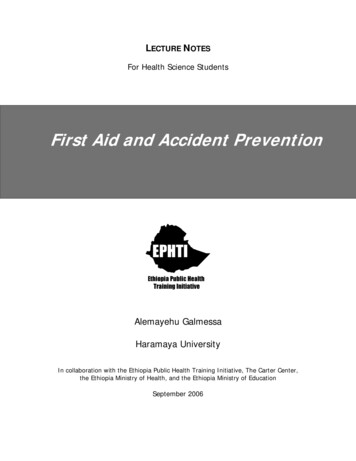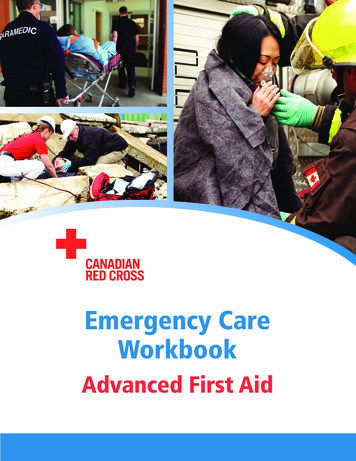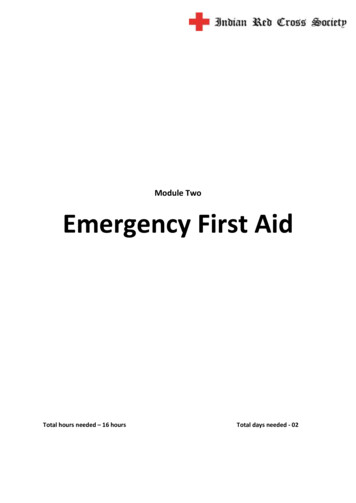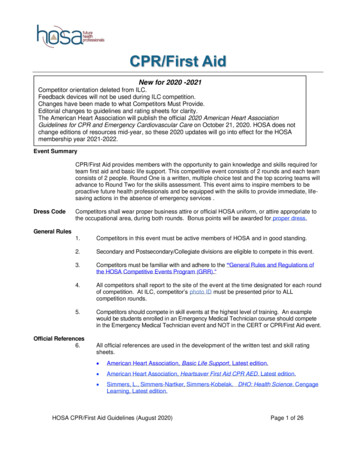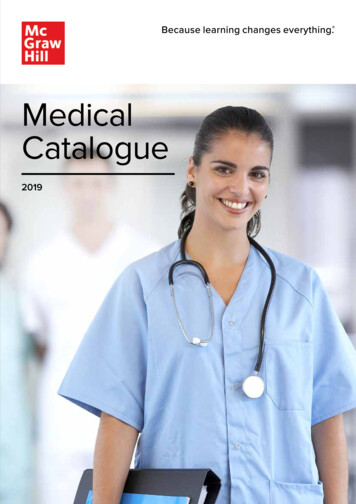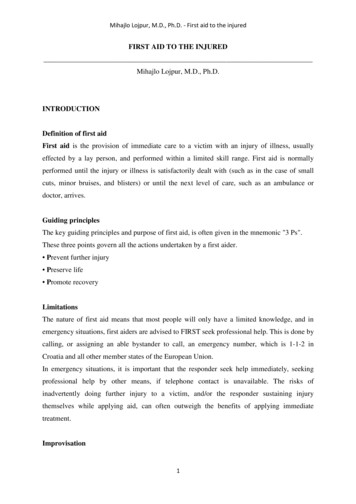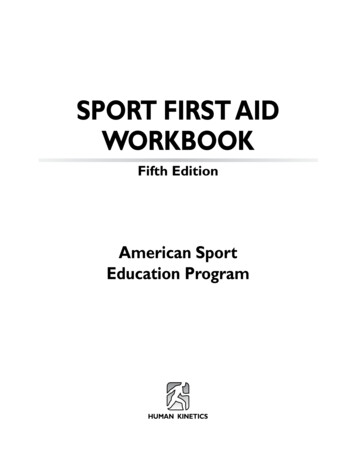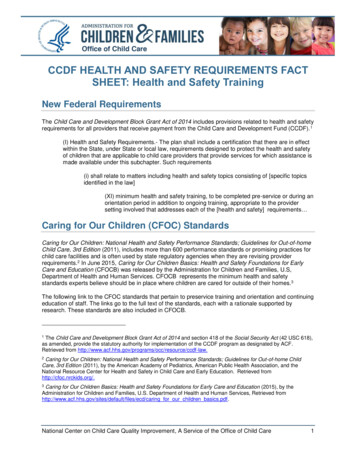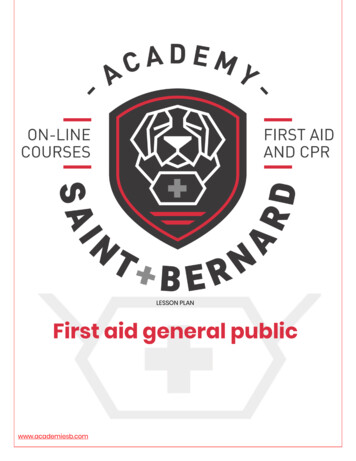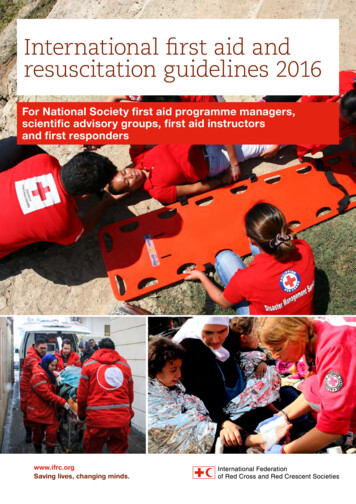
Transcription
International first aid andresuscitation guidelines 2016For National Society first aid programme managers,scientific advisory groups, first aid instructorsand first responderswww.ifrc.orgSaving lives, changing minds.
International Federation of Red Crossand Red Crescent Societies, Geneva, 2016Copies of all or part of this study may be made for noncommercialuse, providing the source is acknowledged The IFRC would appreciate receiving details of its use. Requests for commercial reproductionshould be directed to the IFRC at secretariat@ifrc.org.The opinions and recommendations expressed in this study do notnecessarily represent the official policy of the IFRC or of individualNational Red Cross or Red Crescent Societies. The designations andmaps used do not imply the expression of any opinion on the part ofthe International Federation or National Societies concerning the legalstatus of a territory or of its authorities. All photos used in this studyare copyright of the IFRC unless otherwise indicated. Cover photo:American Red Cross.P.O. Box 303CH-1211 Geneva 19SwitzerlandTelephone: 41 22 730 4222Telefax: 41 22 733 0395E-mail: secretariat@ifrc.orgWeb site: www.ifrc.orgInternational first aid and resuscitation guidelines 20161303500 05/2016 EFollow us on:
International Federation of Red Cross and Red Crescent SocietiesInternational first aid and resuscitation guidelines 2016International first aid andresuscitation guidelines 2016for National Society first aid programmemanagers, scientific advisory groups,first aid instructors and first respondersThe International Federation of Red Cross andRed Crescent Societies (IFRC) is the world’slargest volunteer-based humanitarian network.With our 190 member National Red Cross andRed Crescent Societies worldwide, we are inevery community reaching 160.7 million peopleannually through long-term services anddevelopment programmes, as well as 110 millionpeople through disaster response and earlyrecovery programmes. We act before, during andafter disasters and health emergencies to meetthe needs and improve the lives of vulnerablepeople. We do so with impartiality as tonationality, race, gender, religious beliefs, classand political opinions.Guided by Strategy 2020 – our collective plan ofaction to tackle the major humanitarian anddevelopment challenges of this decade – we arecommitted to saving lives and changing minds.Our strength lies in our volunteer network,our community-based expertise and ourindependence and neutrality. We work toimprove humanitarian standards, as partners indevelopment, and in response to disasters. Wepersuade decision-makers to act at all times inthe interests of vulnerable people. The result:we enable healthy and safe communities, reducevulnerabilities, strengthen resilience and fostera culture of peace around the world.1
International Federation of Red Cross and Red Crescent SocietiesInternational first aid and resuscitation guidelines 20162
International Federation of Red Cross and Red Crescent SocietiesInternational first aid and resuscitation guidelines 2016Table of troduction11About this document12Link to Strategy 2020Where do the guidelines fit in IFRC policy?Definition, trends and facts and figuresDefinition of first aidProgress and trends in first aid: community-based health and first aid in actionNumber of people reached121315151516Process to develop these guidelines17Summary of scientific foundation and guidelinesLocal adaptationFuture development182020General principlesCitizen preparedness for disasters and daily emergenciesPreventionPersonal safetyLinkages to other healthcareUpdate and retrainingTarget populations and their supportersEthicsEducationIntroductionWhat is effective first aid education?Foundation for first aid educationThe effectiveness of first aid education on casualty outcomesMotivation of the learnerThe effectiveness of using different learning modalitiesScenario-based and simulation learningFirst aid education for childrenMeasuring outcomesConclusionsGeneral approachIntroductionAssessmentCasualty positioningCall for help, EMS or further helpMedication 404242434445463
International Federation of Red Cross and Red Crescent SocietiesInternational first aid and resuscitation guidelines 2016First aid for medical conditionsAllergic reaction and second dose of epinephrine for anaphylaxisPoisoningBreathing difficultiesChest painStrokeDehydration and gastrointestinal distressSeizuresFeverDiabetes and hypoglycaemia treatmentUse of oxygenShock and optimal position for shockUnresponsive and altered mental statusFaintingCroupFirst aid for injuriesForeign body airway al spinal motion restrictionChest and abdomen injuriesExtremity injuriesWounds and abrasionsDental avulsionInjuries due to chemical 878990919394Environmental health problems97Health problems caused by coldHealth problems caused by high altitudeRadiation emergencies97100101First aid for animal-related impairmentsAnimal bitesSnakebitesJellyfish stingsInsect bites or stingsDrowning and scuba diving decompression illnessDrowning processCervical spine injury among drowning casualtiesScuba diving decompression illnessResuscitationIntroductionCardiac arrestEarly defibrillationResuscitation in childrenWithholding of resuscitation in cases of traumatic pre-hospital cardiopulmonary arrestMethods of providing 5125130131
International Federation of Red Cross and Red Crescent SocietiesInternational first aid and resuscitation guidelines 2016Psychological first aidIntroductionPsychological first aid principlesDe-escalating techniques for violent behaviourPanic attackExtreme stress and post-traumatic stress disorderSuicidal 181Appendix 1: Global survey data on first aidAppendix 2: Summary table of topics revision181184Note: Medical information changes constantly and therefore, should not be considered current, completeor exhaustive. You should not rely on the information in these guidelines to recommend a course of treatment for yourself or any other individual; doing so is solely at your own risk.These guidelines provide general information for educational purposes only. They are not designed to anddo not provide medical advice, professional diagnosis, opinion, treatment or services. They are not a substitute for medical or professional care, and the information should not be used as an alternative to a visit,call, consultation or advice of a physician or other healthcare provider. The International Federation of RedCross and Red Crescent Societies is not liable or responsible for any advice, course of treatment, diagnosisor any other information, services or product you obtain through these guidelines.5
International Federation of Red Cross and Red Crescent SocietiesInternational first aid and resuscitation guidelines 2016AcknowledgmentsThe Steering Committee of the International Federation of Red Cross andRed Crescent Societies (IFRC) Evidence-Based Network: David Markenson, MD . . . . . . . . . . . . . . . . . . . . . . . . . . . . American Red Cross Philippe Vandekerckhove, MD . . . . . . . . . . . . . . . . . . . . PhD, Belgian Red Cross Pascal Cassan, MD . . . . . . . . . . . . . . . . IFRC Global First Aid Reference CentreThe following team, in addition to the Steering Committee, has coordinated theEvidence-Based Network: Jeffrey L. Pellegrino, PhD, MPH . . . . . . . . . . . . . . . . . . . . . American Red Cross Susanne Schunder-Tatzber, MD . . . . . . . . . . . . . . . . . . . . . . Austrian Red Cross Emmy De Buck, PhD, Centre for Evidence-Based Practice . . Belgian Red Cross Viv Armstrong, MD . . . . . . . . . . . . . . . . . . . . . . . . . . . . . . . . . . British Red Cross Emily Oliver . . . . . . . . . . . . . . . . . . . . . . . . . . . . . . . . . . . . . . . . British Red Cross Andrew MacPherson, MD . . . . . . . . . . . . . . . . . . . . . . . . . . Canadian Red Cross Daniel Meyran, MD . . . . . . . . . . . . . . . . . . . . . . . . . . . . . . . . . . French Red Cross Gabor Göbl, MD . . . . . . . . . . . . . . . . . . . . . . . . . . . . . . . . . Hungarian Red CrossThe following IFRC team participated in the International Liaison Committeeon Resuscitation (ILCOR) process, which developed the first aid Consensuson Science: Richard Bradley, MD . . . . . . . . . . . . . . . . . . . . . . . . . . . . . . American Red Cross David Markenson, MD . . . . . . . . . . . . . . . . . . . . . . . . . . . . American Red Cross Jeffrey L. Pellegrino, PhD, MPH . . . . . . . . . . . . . . . . . . . . . American Red Cross Linda Quan, MD . . . . . . . . . . . . . . . . . . . . . . . . . . . . . . . . . American Red Cross Richard Rusk, MD, MPH . . . . . . . . . . . . . . . . . . . . . . . . . . . American Red Cross S. Robert Seitz . . . . . . . . . . . . . . . . . . . . . . . . . . . . . . . . . . . American Red Cross Nici Singletary, MD . . . . . . . . . . . . . . . . . . . . . . . . . . . . . . . American Red Cross Christina Hafner, MD . . . . . . . . . . . . . . . . . . . . . . . . . . . . . . Austrian Red Cross Susanne Schunder-Tatzber, MD . . . . . . . . . . . . . . . . . . . . . . Austrian Red Cross Emmy De Buck, PhD, Centre for Evidence-Based Practice . . Belgian Red Cross Philippe Vandekerckhove, MD, PhD . . . . . . . . . . . . . . . . . . . . Belgian Red Cross Andrew MacPherson, MD . . . . . . . . . . . . . . . . . . . . . . . . . . Canadian Red Cross Gabor Göbl, MD . . . . . . . . . . . . . . . . . . . . . . . . . . . . . . . . . Hungarian Red Cross Pascal Cassan, MD . . . . . . . . . . . . . . . . IFRC Global First Aid Reference CentreThe following representatives from across the Red Cross Red CrescentMovement have participated in the work of the Evidence-Based Network eitheras members or contributors and/or in attending some of the meetings held toprepare the writing of these guidelines: Fitzmorris T. Martin . . . . . . . . . . . . . Antigua and Barbuda Red Cross Society Melisa Pasquali . . . . . . . . . . . . . . . . . . . . . . . . . . . . . . . . . . Argentine Red Cross Cornel Binder-Kriegelstein, PhD . . . . . . . . . . . . . . . . . . . . . Austrian Red Cross Christina Hafner, MD . . . . . . . . . . . . . . . . . . . . . . . . . . . . . . Austrian Red Cross Supriya Saha . . . . . . . . . . . . . . . . . . . . . . . . . Bangladesh Red Crescent Society Denis Larger, MD . . . . . . . . . . . . . . . . . . Bataillon de Marins Pompiers de Marseille Vere Borra, PhD . . . . . . . . . . . . . . . . . . . . . . . . . . . . . . . . . . . . Belgian Red Cross Matthieu Clarysse . . . . . . . . . . . . . . . . . . . . . . . . . . . . . . . . . . Belgian Red Cross Sylvie Libotte . . . . . . . . . . . . . . . . . . . . . . . . . . . . . . . . . . . . . . Belgian Red Cross Axel Vande Veegaete . . . . . . . . . . . . . . . . . . . . . . . . . . . . . . . . Belgian Red Cross Hans Van Remoortel, PhD . . . . . . . . . . . . . . . . . . . . . . . . . . . . Belgian Red Cross Maggi Aslet . . . . . . . . . . . . . . . . . . . . . . . . . . . . . . . . . . . . . . . . British Red Cross Andrew Farrar . . . . . . . . . . . . . . . . . . . . . . . . . . . . . . . . . . . . . . British Red Cross Piers Flavin . . . . . . . . . . . . . . . . . . . . . . . . . . . . . . . . . . . . . . . . . British Red Cross Jane Hasler . . . . . . . . . . . . . . . . . . . . . . . . . . . . . . . . . . . . . . . . . British Red Cross6
International Federation of Red Cross and Red Crescent SocietiesInternational first aid and resuscitation guidelines 2016 David McKinney . . . . . . . . . . . . . . . . . . . . . . . . . . . . . . . . . . . . British Red CrossJoe Mulligan . . . . . . . . . . . . . . . . . . . . . . . . . . . . . . . . . . . . . . . . British Red CrossTracey Taylor . . . . . . . . . . . . . . . . . . . . . . . . . . . . . . . . . . . . . . . British Red CrossPencho Penchev . . . . . . . . . . . . . . . . . . . . . . . . . . . . . . . . . . Bulgarian Red CrossCharles Manirambona . . . . . . . . . . . . . . . . . . . . . . . . . . . . . . Burundi Red CrossDon Marentette . . . . . . . . . . . . . . . . . . . . . . . . . . . . . . . . . . Canadian Red CrossGrace Lo . . . . . . . . . . . . . . . . . Red Cross Society of China – Hong Kong BranchYuet Chung Axel Siu, MD . . . Red Cross Society of China – Hong Kong BranchThompson Leung . . . . . . . . . . Red Cross Society of China – Hong Kong BranchKristiina Myllyrinne . . . . . . . . . . . . . . . . . . . . . . . . . . . . . . . . Finnish Red CrossAugustin Baulig, PhD . . . . . . . . . . . . . . . . . . . . . . . . . . . . . . . . French Red CrossHripsimé Torossian . . . . . . . . . . . . . . . . . . . . . . . . . . . . . . . . . . French Red CrossChristoph Müller, Diploma Education Scientist . . . . . . . . . . German Red CrossEric Bernes, MD . . . . . . . . . . . . . . . . International Committee of the Red CrossNana Wiedemann . . . . . . . . . IFRC Reference Centre for Psychosocial SupportNiamh O’Leary . . . . . . . . . . . . . . . . . . . . . . . . . . . . . . . . Irish Red Cross SocietyEun Young Park . . . . . . . . . . . . . . . . The Republic of Korea National Red CrossRosabelle B. Chedid, MSc . . . . . . . . . . . . . . . . . . . . . . . . . . . Lebanese Red CrossAlick Msusa . . . . . . . . . . . . . . . . . . . . . . . . . . . . . . . . . Malawi Red Cross SocietyKhin Khin Shein . . . . . . . . . . . . . . . . . . . . . . . . . . . Myanmar Red Cross SocietyNatasja Oving . . . . . . . . . . . . . . . . . . . . . . . . . . . . . The Netherlands Red CrossCees van Romburgh . . . . . . . . . . . . . . . . . . . . . . . . The Netherlands Red CrossPeter Paul Tenthof van Noorden . . . . . . . . . . . . . . The Netherlands Red CrossAmna Khan, MD . . . . . . . . . . . . . . . . . . . . . . . . . Pakistan Red Crescent SocietyJosé Manuel Almeida do Couto . . . . . . . . . . . . . . . . . . . . Portuguese Red CrossLjubica Aleksic, MD . . . . . . . . . . . . . . . . . . . . . . . . . . . . The Red Cross of SerbiaLars Adamsson . . . . . . . . . . . . . . . . . . . . . . . . . . . . . . . . . . . . Swedish Red CrossChristoph Bosshard . . . . . . . . . . . . . . . . . . . . . . . . . . . . . . . . . . Swiss Red CrossPaul Bitex Okot, MPH . . . . . . . . . . . . . . . . . . . . . . . . . Uganda Red Cross SocietyAyikanying Morris . . . . . . . . . . . . . . . . . . . . . . . . . . . Uganda Red Cross SocietyBarbara Juen, PhD . . . . . . . . . . . . . . . . . . . . . . . . . . . . . University of InnsbruckMohammed Al Fakeeh . . . . . . . . . . . . . . . . . . . . . Yemen Red Crescent SocietyThe participation and/or past and present evidence-based work of the following organizations and agencies were invaluable in the development of theseguidelines: Belgian Red Cross Centre for Evidence-Based Practice (CEBaP) European Resuscitation Council First Aid Education European Network IFRC Global First Aid Reference Centre (GFARC) IFRC Reference Centre for Psychosocial Support International First Aid Science Advisory Board International Liaison Committee on Resuscitation (ILCOR) Scientific Advisory Council of the American Red CrossWe would like to thank the following colleagues for their exemplary andtireless efforts in translating the scientific evaluations into implementationconsiderations for this document: Emmy De Buck, PhD . . . Centre for Evidence-Based Practice, Belgian Red Cross Emily Oliver . . . . . . . . . . . . . . . . . . . . . . . . . . . . . . . . . . . . . . . . British Red Cross Salomé Boucif . . . . . . . . . . . . . . . . . . . . . . . . . . . . . . . . . . . . . . French Red Cross Jean-Daniel Féraud . . . . . . . . . . . . . . . IFRC Global First Aid Reference CentreWe also wish to acknowledge the first aid managers, trainers and volunteers whowill implement this information in the programmes they design and deliver, andthe countless individuals who will use this information and skills to save lives.7
International Federation of Red Cross and Red Crescent SocietiesInternational first aid and resuscitation guidelines 20168
International Federation of Red Cross and Red Crescent SocietiesInternational first aid and resuscitation guidelines 2016ForewordA young volunteer treats an injured soldier as a battle rages around them. Avolunteer bandages a young girl’s head in the aftermath of an earthquake.A team of volunteers tend to the survivors of a building collapse.First aid is central to our identity around the world. For many people, whenthey think of the Red Cross and Red Crescent, they think of our volunteers onthe frontline of humanitarian crises, treating the wounded and sick, or of thetraining that we provide in schools, community centres, and places of work.The members of the International Federation of Red Cross and Red CrescentSocieties (IFRC) are some of the leading providers of first aid in the world. Formore than 150 years, first aid has been one of the principal services providedby Red Cross and Red Crescent volunteers to injured people.Each year, National Red Cross Red Crescent National Societies train more than15 million people in first aid. There are currently more than 180,000 active firstaid trainers serving their communities, making first aid available for all.Why is this so important? Because when a disaster strikes, no first respondercan respond as quickly as a neighbour or family member. And when that person knows first aid, crisis can be averted, and lives can be saved.For more than 100 years, the Red Cross and Red Crescent has been a worldleader in establishing training standards and in developing procedures andguidelines. Drawing on our extensive experience we have helped shape theworld’s understanding of, and approach to, first aid.The International first aid and resuscitation guidelines 2016 are designed to helpNational Societies expand their work in this important area. They build on ourextensive experience, and draw on evidence that has been gathered over thepast two decades, evidence drawn from existing literature, programme evaluations, and advice from experts.The 2016 guidelines are targeted at National Societies’ first aid programmemanagers and their first aid advisory bodies. National Societies can use theseguidelines to update their first aid materials, education and skills in accordance with the latest evidence-based international standards. Each topic withinthis document includes an introduction and summary of the scientific findings,evidence-based guidelines and implementation considerations for NationalSocieties to adapt and apply according to their local needs, circumstances andgovernment legislation. This document represents the first stage in an ongoing IFRC effort to provide National Societies with evidence-based guidance forfirst aid, resuscitation and education through the work of our Evidence-BasedNetwork.Strategy 2020 calls on all of us to do more, do better and reach further. First aidremains a key means of reducing deaths and injuries, and of building safer andmore resilient communities.Elhadj As SyIFRC Secretary General9
International Federation of Red Cross and Red Crescent SocietiesInternational first aid and resuscitation guidelines 2016AbbreviationsAMSAcute Mountain SicknessABCDEAirway, breathing, circulation, disability, exposureAEDAutomated external defibrillatorAGEArterial gas embolismBVMBag-valve-maskBLSBasic life supportCPRCardiopulmonary resuscitationCEBaPBelgian Red Cross Centre for Evidence-Based PracticeCPSSCincinnati Pre-Hospital Stroke ScaleCBHFACommunity-based health and first aidDOIDigital object identifierDANDiver Alert NetworkEMSEmergency medical servicesFASTFace, arms, speech and timeFBAOForeign body airway obstructionGCSGlasgow Coma ScoreGFARCGlobal First Aid Reference CentreHACEHigh altitude cerebral oedemaHAPEHigh altitude pulmonary oedemaIASCInter Agency Standing CommitteeICRCInternational Committee of the Red CrossIFRCInternational Federation of Red Cross and Red Crescent SocietiesILCORInternational Liaison Committee on ResuscitationKPSSKurashiki Pre-hospital Stroke ScaleLAPSSLos Angeles Pre-hospital Stroke ScalemTBIMinor traumatic brain injuriesOPSSOntario Pre-hospital Stroke ScaleORSOral rehydration saltsPLRPassive leg raisingROSIERRecognition of stroke in the emergency roomSAMPLESigns and symptoms, allergies, medication, past medical history, last meal, eventThe Movement The Red Cross Red Crescent MovementTIATransient ischemic attackTTMTranstheoretical model of behaviour changeVFVentricular fibrillation10
International Federation of Red Cross and Red Crescent Societies01. Introduction01.Introductionbackto table ofcontentsFirst aid remains a core area of the International Federation of Red Cross andRed Crescent Societies (IFRC). The IFRC is a major first aid educator and provider in the world. Almost all 190 Red Cross Red Crescent National Societieshave first aid as their core activity, and first aid, the act of saving a life, is central to the Fundamental Principles.The IFRC believes that first aid is a vital initial step for providing effectiveand rapid intervention that can help reduce injury and suffering and improvethe chances of survival. Taking immediate action and applying correct andappropriate first aid measures makes a difference. Having high quality, evidence-based first aid education available to people worldwide contributes tobuilding safer and healthier communities by preventing and reducing risks indaily emergency and disaster situations.The IFRC advocates for first aid to be accessible to all and that at least oneperson in each household has access to learning first aid regardless of theirsocioeconomic status or other potential discriminatory factors.11
International Federation of Red Cross and Red Crescent SocietiesInternational first aid and resuscitation guidelines 201602.About this documentThis document evaluates and reports on the science behind first aid and resuscitation. The International First Aid and Resuscitation Guidelines (referred to as theguidelines) have been produced with the main goal of fostering harmonization of first aid practices among the Red Cross Red Crescent National Societiesand provide a true evidence-base to these practices. It is part of quality assurance to ensure that the general public and volunteers receive first aid trainingin accordance with IFRC standards and to establish, in due course, the IFRCInternational First Aid Certification.backto table ofcontentsThese guidelines do not replace first aid manuals and associated educationalmaterials but serve as the basis for developing and updating first aid manuals,resuscitation programmes, apps, public information and associated educational materials. National Societies should adapt these guidelines as needed fortheir local contexts (culture, language, habits etc.), legal context, local prevalence of injuries or illnesses and their own capacities (see Local adaptation). Inaddition, these guidelines and evidence review serve as an excellent referencefor first aid instructors, emergency responders and their agencies.Link to Strategy 2020In line with Strategy 2020, Red Cross Red Crescent National Societies committo do more, do better and reach further. These guidelines provide NationalSocieties a solid base to do better in first aid.With the global trend moving towards greater urbanization, the negativeimpact on health is increasing, particularly among vulnerable communities.Promoting first aid and using proven prevention techniques to address some ofthese challenges can build the capacity of local communities and the NationalSocieties in both preparedness and response. This effort bridges the initialresponse of first aid volunteers and the public to the formal health system insaving lives.12
International Federation of Red Cross and Red Crescent Societies02. About this documentWhere do the guidelinesfit in IFRC policy?First aid must be delivered using up-to-date, evidence-based guidelines andbest practice. The IFRC supports National Societies and participates in thedevelopment of harmonized first aid techniques in accordance with scientificresearch, international standards, good practice guidelines and measures ofquality services. All of this is linked with a good implementation policy developed through a wide consultative intergovernmental and inter-associativeprocess established at regional and national levels.To do this, the IFRC sets up alliances with scientific bodies, public healthexperts and pedagogical specialists. The resulting information includes trendand situation analysis and the latest evidence-based developments in the fieldof first aid education. These guidelines as well as the Consensus on Science infirst aid were developed using this process.The 32nd International Conference of the Red Cross and Red Crescent(8–10 December 2015) passed a resolution on legal aspects of first aid to: Encourage States to promote regularly refreshed first aid education acrossthe life-span of their citizens, in particular through mandatory training forschool children and teachers and, to the degree capacity allows, for driver’slicence applicants. Encourage States to adopt and regularly update official guidelines as to theminimum content of first aid education programmes, taking into accountstandards already in use, including IFRC International first aid and resuscitation guidelines, as well as the results of impact assessments. Encourage States to consider all necessary steps to encourage the provisionof first aid by laypersons with appropriate training, including, where appropriate, establishing protection from liability for their good faith efforts andensuring that they are aware of this protection. Invite States to exchange good practices in this area and requests NationalSocieties and the International Federation to support interested States inassessing and, as needed, strengthening their existing legal frameworksrelated to first aid.As agreed in the resolution, these guidelines are a reference tool that will contribute to the harmonization of first aid education and training programmesaround the world and assure that these are based on the latest evidenceand information.A distinction is made between harmonization and standardization. The intention is not to have one technique for each situation, but rather to have aconsensus on minimum agreed principles based on critical review of the available evidence and information learnt from the experiences of the Red CrossRed Crescent Movement (the Movement). This is to ensure that all first aid providers practice evidence-based lifesaving techniques.13
International Federation of Red Cross and Red Crescent SocietiesInternational first aid and resuscitation guidelines 2016Several parameters guided these harmonization efforts. The major ones consist of the following: The promotion and inclusion of evidence-based first aid, resuscitation andeducational approaches. The necessity to further disseminate consistent techniques of first aid andresuscitation, knowledge and practices. The educational focus on retaining skills and instilling confidence to act. The ongoing cross-border exchanges due to:–– migration, which leads to mixing of populations;–– tourism and business travel, putting people in different environments;–– use of the internet, which can support self-learning and comparisonbetween areas. The differences between techniques that are not justified by either scientificevidence or field experiences. The necessary bridging between scientific knowledge and its application indiverse situations that is different from the research condition.14
Internation
First aid is central to our identity around the world. For many people, when they think of the Red Cross and Red Crescent, they think of our volunteers on The Internati

